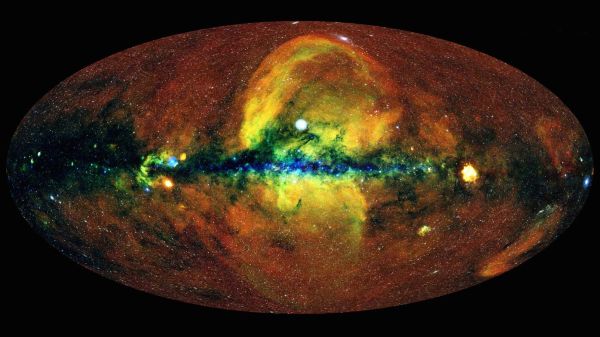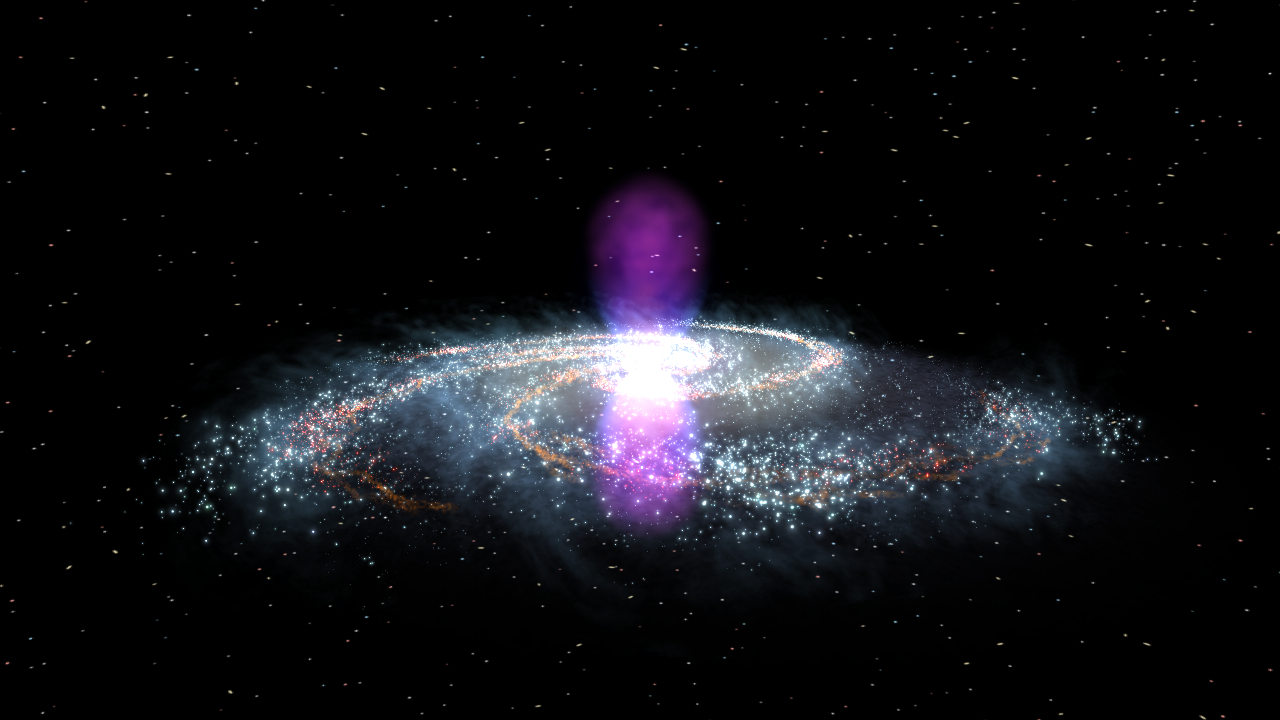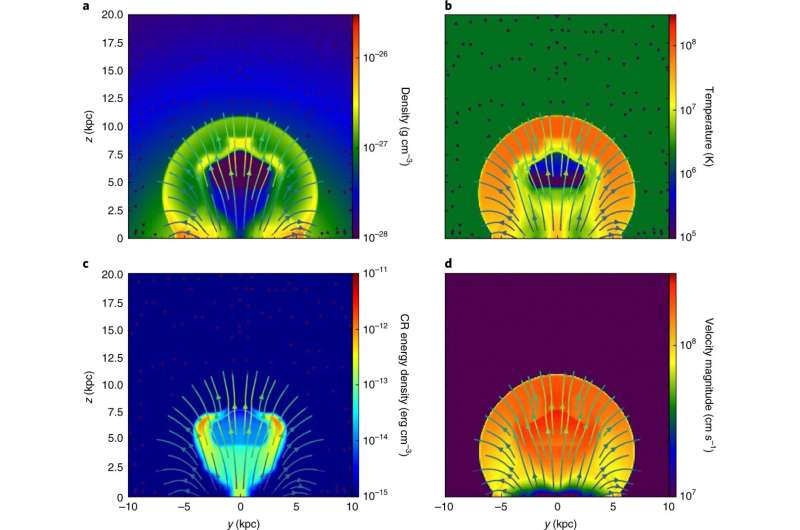Gargantuan 'Fermi bubbles' are the result of a 100,000-year-long black hole explosion, study suggests
Our galaxy's supermassive black hole had a real mean streak.

Two of the strangest, most colossal structures in the Milky Way may have formed in a 100,000-year-long explosion at our galaxy's center, new research suggests.
Those structures — named the Fermi bubbles and eROSITA bubbles after the respective telescopes that discovered them — straddle the Milky Way's center in an enormous hourglass shape, with one set of bubbles stretching more than 25,000 light-years above the galactic plane, and the other set stretching just as far below it.
The two sets of bubbles overlap with each other, but they appear to be made of fundamentally different stuff. The Fermi bubbles, filled with ultra-fast particles called cosmic rays, can only be spotted by telescopes that detect high-energy gamma rays, while the eROSITA bubbles — filled with blazing hot gas — are only visible as X-rays. Scientists dispute their origins, but one thing about the bubbles is clear: They are the result of an ancient and powerful explosion that ignited somewhere near the galaxy's center long ago.
Now, in a new study published March 7 in the journal Nature Astronomy, researchers describe how they simulated the explosive history of the Fermi and eROSITA bubbles to determine exactly where, when and how they were created. Using data from both the gamma-ray and X-ray surveys that uncovered the mysterious structures, the study authors show that both sets of bubbles likely resulted from a lengthy outburst from the supermassive black hole at the center of our galaxy, beginning 2.6 million years ago.
Triggered by thousands of suns-worth of matter falling into the black hole over tens of thousands of years, the outburst would have shot twin jets of high-energy particles into space at near-light speed, inflating the giant bubbles and pushing nearby matter far across the galaxy, the researchers said.
If the team's models are accurate, they show that our galaxy's central black hole — while relatively quiet today — was once a raging tempest of energy with a monstrous hunger for nearby matter.
"According to our estimate of the jet power required to inflate the Fermi/eROSITA bubbles, the galactic black hole had a very good appetite," lead study author Karen Yang, an assistant professor at the National Tsing Hua University in Taiwan, told Live Science. "It consumed materials of about 1,000 to 10,000 solar masses within a period of 100,000 years, beginning about 2.6 million years ago."
Get the world’s most fascinating discoveries delivered straight to your inbox.
Related: The 10 strangest space structures discovered in 2021
Inflation gone wild
Astronomers detected the Fermi bubbles with NASA's Fermi gamma-ray telescope in 2010. A decade later, a separate team of scientists detected the eROSITA X-ray bubbles in nearly the exact same spot — though this new pair of gargantuan orbs appeared to be even larger than the first, extending for thousands of light-years beyond the edges of the Fermi bubbles.
Scientists consider two plausible explanations for the existence of these behemoths: Either they formed from an extremely powerful supernova explosion near the center of the galaxy, or they were violently spit out of Sagittarius A* — the supermassive black hole at the galaxy's center, containing the mass of about 4 million suns.
Various studies have attempted to prove one explanation or the other, but the new paper is the first to offer an explanation by modeling the evolution of both the Fermi and eROSITA bubbles simultaneously.
"Our simulations are unique in that they can model the interaction between the high-energy particles (that produce the gamma rays) and the gas within the Milky Way (that produce the X-rays)," Yang told Live Science.
Using the shape, size and spectra (that is, the wavelengths of light they emit) of both bubbles as a starting point, the team estimated the amount of energy needed to inflate them to their current proportions. They found that the only plausible explanation was a powerful and protracted black hole outburst; a single supernova just wasn't going to cut it.
Such an outburst would have inflated the bubbles in phases, the team wrote. First, a tremendous amount of matter needed to fall into Sagittarius A*. Rather than being completely gobbled up, some of that matter was channeled into enormous, fast-moving jets that accelerated matter away from the black hole at near-light-speed. (Jets like these have been observed blasting out of black holes in other galaxies).
Acting like giant particle accelerators, those jets turned protons and neutrons into high-energy cosmic rays that screeched across the galaxy. As those rays streamed into space, they began to fill up the Fermi bubbles, the researchers said.
And while the Fermi bubbles expanded across the Milky Way in a high-speed explosion, they pushed aside ambient gas they encountered along the way, creating an enormous shock wave that's still visible today. That wave of heated gas glows with X-ray radiation — which we see as the eROSITA bubbles, surging outward around the sides of the Fermi bubbles, the researchers said.
If the team's models are accurate, they not only explain the origins of two of the most mysterious structures in our galaxy — they also give scientists a close-up look at how supermassive black holes can mold and change the galaxies around them. Further study of the bubbles is needed to finally put this cosmic mystery to rest.
Originally published on Live Science.

Brandon is the space / physics editor at Live Science. With more than 20 years of editorial experience, his writing has appeared in The Washington Post, Reader's Digest, CBS.com, the Richard Dawkins Foundation website and other outlets. He holds a bachelor's degree in creative writing from the University of Arizona, with minors in journalism and media arts. His interests include black holes, asteroids and comets, and the search for extraterrestrial life.


